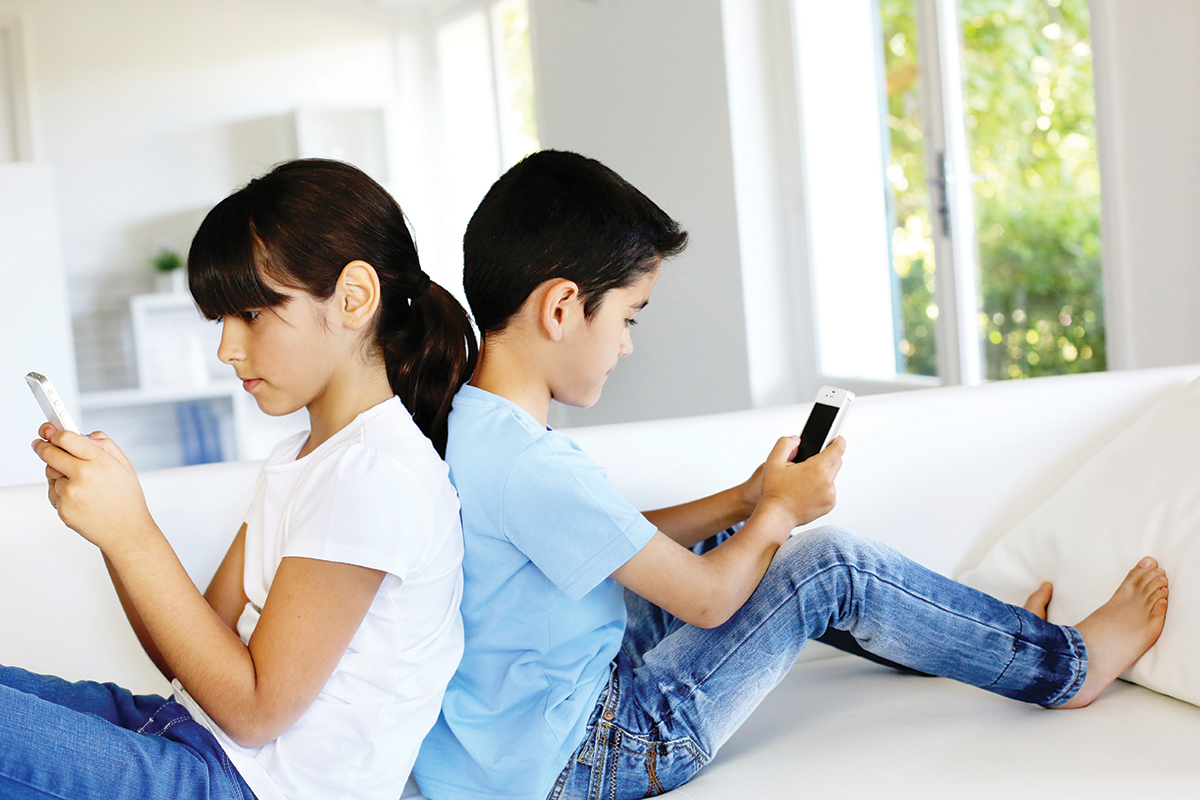
Unless you’re living off the grid, chances are this sounds familiar: You’re making dinner, you’re in line at the store, you’re waiting for school to let out — and you can’t stop staring at the little glowing screen in your hand.
The latest smartphone research points to parents’ usage as a problem. In a small pilot study, Boston Medical Center researchers observed 55 parents at fast-food restaurants. They noted that 44 caregivers used mobile devices during meals, and those absorbed in the world at their fingertips “often responded harshly to child misbehavior.”
Why does a small study like this send up an alert when we talk about tween smartphone users? “How parents behave still matters to your child, even if it appears to you that by definition, your tween is doing the exact opposite behavior,” says Steve C. Schlozman, M.D., codirector of the Clay Center for Healthy Young Minds at Massachusetts General Hospital. Despite the very real factor of teen and preteen rebellion, our children are still watching us and modeling much of their behavior on our actions.
So it follows that parental actions impact tweens’ relationships with their phones — devices that are practically unrecognizable from the ones we grew up using. To counter our own bad behavior, we’ve gathered tips from a range of experts on how to teach our kids to stay connected in a human way while making healthy use of the inevitable smartphone technology.
Model leaving your phone behind
An important part of setting an example is verbally acknowledging your behavior. When you don’t bring your phone on a father-son bike ride, for example, say that you left it behind so you can focus on this time together. Create rules that make sense for your family, whether that means turning off phones between 9 p.m. and 9 a.m., unplugging during dinner or having text-free Tuesdays.
Kirsten Cullen Sharma, Psy.D., clinical assistant professor of child and adolescent psychiatry at New York University’s Langone Medical Center, says parents must be very proactive about smartphone usage expectations. “Sometimes you might need to outline that this is the expectation for the day and for the activity we are going to, and be willing to engage in the discussion or argument around a limit,” she says. “And when your child is on their phone instead of engaging with you, verbalize your perspective: ‘I am with you and you are engaging on the phone instead, and this is how I feel when you do that.’”
In the same vein, make space for smartphone-free activities. Although the American Academy of Pediatrics recommends no more than two hours of media time daily for kids ages 6–18, youth are spending four to five times that amount, according to the Kaiser Family Foundation. Tweens with too much free time gravitate toward media — it’s much harder to text while you’re playing soccer or sewing.
Exemplify the limits of texting
“Kids who have good social skills have a lot of practice reading people’s facial expressions, and [they] know how to look for social nuances and cues,” Sharma says. Too much texting can get in the way of learning these skills.
In everyday conversation, share your experiences of when you couldn’t suss out the real meaning behind something in writing. Schlozman tells his own daughter it’s time to call her friend or talk in person when she becomes upset with texting conversations. “Tween and teen brains are wired to read things more critically; they are going to see insult when it’s not there,” he says, adding that it is our job to teach them about the nuances of human communication.
Ask permission to post pictures and videos
Before you post that great picture of your daughter on her unicycle, ask her if it’s OK, says Jo Langford, M.A., a Seattle-area therapist and sex educator for boys and their parents. Talk about how she should take the same step when it comes to her own media.
We forget that our children don’t necessarily share our mind-set about technology. “My daughter — because she hasn’t lived in my generation — doesn’t have a clear sense of privacy. She doesn’t know that I can see her social media profiles,” says Karen Maezen Miller, author of Paradise in Plain Sight: Lessons from a Zen Garden and mom to a 14-year-old girl.
Keep the conversation going
Katie LeClerc Greer, a national expert on cybersafety, says kids ages 8–18 spend an average of 7.5 hours per day engaging with technology, and you have to be willing to monitor your child’s smartphone time as soon as you hand him one. The dangers of the digital world should be a regular topic of conversation in your house, and you must set expectations around usage.
“This is what I recommend to parents: Talk, talk, talk,” says Greer. “Kids are your best resources. Ask them to show you their favorite apps and how to use them. A lawyer I met said he made his daughter tell him the pros and cons of every app she wanted permission to purchase. She had 30 seconds, and if she didn’t tell him about the cons he uncovered during his own research, she would lose her phone privileges.”
Be straightforward yet casual during these conversations, Schlozman says. “Say, ‘Hey, we need to talk about what apps you have on your cell phone, and tell me why you like them’ — with the understanding that they will hold some stuff back,” he says. “Making the conversation ordinary means they can come back to you later when they are in trouble. The goal is to make your house a safe place, so they are not going to be ashamed to ask for help.”
Of course, another tangible goal and reward of smartphone culture is increased communication between parents and tweens. “Nothing makes my day more fulfilled than if I get a text from my daughter that says ‘LOL,’” Miller admits. “That’s a wonderful moment.”
Outsmarting smartphones
Learning to drive a smartphone is like learning to drive a car, therapist Jo Langford says. “We need to be in the passenger seat of the smartphone. Tweens need a copilot until they are ready to navigate this tool on their own.” What can you do to set them on the right course?
Treat smartphone time as a privilege, and reward kids with more device time as they earn it, says psychiatrist Kirsten Cullen Sharma. “Starting on day one, give your tween very structured use and time for the phone, and monitor all of their texting and online and app usage.”
Keep an eye on their activity. Your cell phone provider should have easy monitoring tools available, and this article walks parents though the basics of smartphone monitoring.
Know the latest apps that may put your tween in the path of danger. Check Common Sense Media and Katie LeClerc Greer’s website on a regular basis for the latest news about mobile device safety.
Create a contract with your tween cell user. Check out Langford’s sample smartphone contract.











